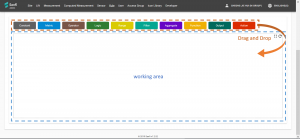Adding a rule
Contents
Pre-requisites
A rule requires design and logical programing in order for it to work correctly. If this is your first time creating a rule, please read this guide first.
You should also be similar with the basic measurements and its concepts. Please read this section if you require a refresher.
You should
- Know what event the Rule should detect.
- Know what you would like Senfi to do (Action) when the event is detected
- Have already created the Input measurement & metrics.
- Know the thresholds or values which indicates occurrence of event.
- Be able to send records to Input measurement & metric.
- (Optional) Be able to send simulated records to Input measurement & metric (to simulate occurrence of event or situation)
Adding a New Rule
- Login to the CMS
- Go to the Rule tab
- Click the + button to add a new rule.
- Give the rule a descriptive name. This will be shown to users of the dashboard.
- Select the Severity of the rule.
- Select Evaluate Type of the rule. Read this section if you require a refresher
- (Optional) Select the Access Group that would be able to view and modify the rule. Defaults to all users in your organization.
- Give the rule a descriptive Description. The Description would be the default content for any Action
- Construct the Conditions using the editor. Constructing the Condition for more details.
- Save when done
- (Optional) Send records to simulate event to test the rule.
Constructing Condition
This section will guide you to construct a condition using the Editor when adding/editing a Rule in the CMS
The Rule Editor is a graph based "Drag and Drop" editor. Each node in the Editor represents either an Input, Data Transformation, Logic, or an Action. Arrows are used to link the nodes and indicates flow of data between nodes.
- Input Nodes
- Constant - supplies a constant value. e.g. 0, 1, true, false
- Metric - the latest value from a metric
- Input modifier Nodes
- Range - modifies the "Metric" node to supply historical values
- Logic Nodes
- Operator - comparison operators. e.g. <, >=, ==, !=
- Logic - perform "AND" or "OR" between 2 or more boolean values
- Data Transformation Nodes
- Filter - to be used with "Range" node. Filters input values to output a subset number of values.
- Aggregate - to be used with "Range" node. Aggregates input values into a single value. E.g. sum, average, median.
- Function - value-wise transformation. Can be used directly with a "Metric" node, or with "Range" node. Outputs the same number of values as its input.
- Output Node
- Output - output node. Must have 1 and only 1 node. Specifies the output of the Conditions
- Action Nodes
- Action - action node. Input must aways be from Output node. Can 0 or more Action nodes. Instructs Senfi to do something when Output changes.
By default, a "Metric" node will output the Last Known value of the metric. Attaching a Range node to it allows modifies the "Metric" node to output historical values.
Configuring a node
Each node contains attributes & options which you can modify. To modify the attributes of a node, move your mouse over the node and click on the "Gear" button that appears near the top right corner of the node (Beside the "X" button). A window will popup to allow you to configure the node.
Steps
- Drag "Metric" nodes into the working area, one for each Input metric.
- Select the correct measurement and metric for each created "Metric" node. Read how to configure a node if you're unsure how to perform this step.
Configuring Nodes
TODO: go through each node and what each configuration option does

